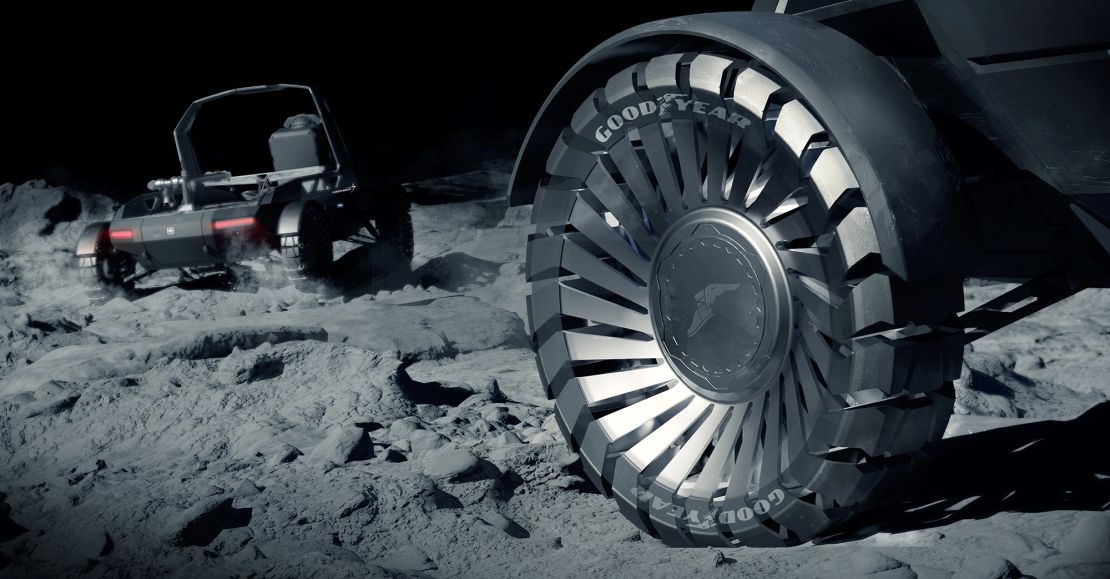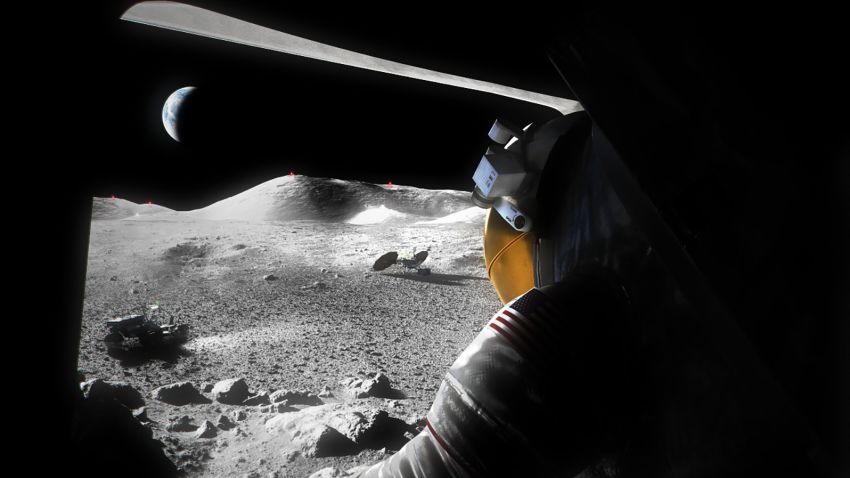General Motors and Lockheed Martin are working together on a new Lunar Rover. but it needs tires. So, Goodyear is now joining the team.
GM (GM) and Goodyear (GT) have been over this dry, dusty ground before. Both companies worked on NASA’s original Lunar Roving Vehicles that went to the moon in the early 1970s. GM (GM) (then working with Boeing, instead of Lockheed Martin) and the three lunar rovers they created are still up there sitting on Goodyear (GT) tires made from wire mesh.
Tires like the ones we use on Earth — made from rubber and filled with air — won’t work on the moon for a few reasons.
First, enormous temperature swings from up to 260 degrees Fahrenheit in the daytime down to -280 degrees at night makes an air-filled tire impossible. Air expands and contracts as temperature changes, so keeping an air-filled tire from going flat at night or exploding during the day would be extremely difficult.
Second, the moon is bathed in intense radiation that degrades rubber because there is no atmosphere.

Nevermind the fact that changing a flat tire on the moon wouldn’t be easy in stiff spacesuit gloves.
The challenges are even greater this time than they were 50 years ago, though. The original Lunar Rovers were, essentially, disposable. They were designed to work for a short time then, as planned, they were abandoned. The new Rovers — which are electric, like the originals, since internal combustion engines also wouldn’t work on the airless moon — can be recharged over and over so they can keep working for years.
Plans call for them to also operate autonomously so they could be up there driving around and doing things even when people aren’t around. This also means the rovers will be exposed to more extreme temperature changes for longer periods. A moon day and a moon night can be two weeks long, each. And, each sunrise and sunset, temperatures change from extreme hot to extreme cold almost instantly.
The partner companies are talking about allowing private firms, organizations, and international agencies, not just NASA, to use them for projects on the moon. Given the longer operational life expected from these new tires — and the fact that it’ll be a very long wait for “roadside assistance” on the moon — Goodyear is exploring new technologies.
Technically, the Lunar Rover won’t have tires in the traditional sense. The wheels and tires will be one piece, as with the airless tires used on Earth. Goodyear uses airless rubber on experimental autonomous delivery vehicles where there’s no driver to change tires. Michelin sells similar airless tires for lawnmowers and other equipment. They rely on rubber ribs instead of air to hold the outer tread. Goodyear’s lunar tires might use springy metal ribs, instead. The tread surfaces might also be made of metal but it wouldn’t have the typical solid blocky tread you see on terrestrial tires.
“It’s more like an open weave or mesh with different types of three-dimensional features,” said Michael Rachita, senior program manager for non-pneumatic tires at Goodyear.
The tires will need to use special metal alloys to withstand the extreme temperature changes while still retaining flexibility and strength. Recreating the extreme cold of a lunar night is especially challenging on Earth because, at those temperatures, air would become a liquid. Tests must be done in a vacuum, said Kirk Shireman, Lockheed’s vice president for lunar exploration.
The moon’s surface is covered in fine super-abrasive sand. Because there’s no air or wind on the moon, the sand particles don’t get moved around and worn smooth, so each particle has sharp points. There are companies that make artificial moon dust based on samples brought back by the 1960s and ’70s Apollo missions, said Rachita, so Goodyear’s researchers are using that to test different tread patterns.
It can be glued to paper or board to make “moon sandpaper” to test abrasion resistance, he said.
GM, Goodyear and Lockheed Martin (LMT) hope to have Lunar Rovers already parked and waiting on the moon before NASA sends astronauts there in 2025. The companies hope to become the first to establish extended commercial vehicle operations on the moon’s surface, they said in an announcement.











